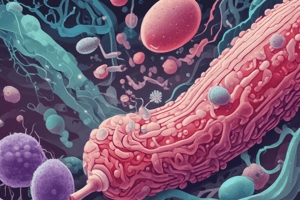Podcast
Questions and Answers
Who is credited with the discovery of penicillin?
Who is credited with the discovery of penicillin?
During which era did the 'golden era' of antibiotic discovery take place?
During which era did the 'golden era' of antibiotic discovery take place?
Which bacterium was identified as methicillin-resistant in the 1960s?
Which bacterium was identified as methicillin-resistant in the 1960s?
What type of antibiotics were streptomycin and chloramphenicol?
What type of antibiotics were streptomycin and chloramphenicol?
Signup and view all the answers
What expanded the antibiotic arsenal in the post-World War II era?
What expanded the antibiotic arsenal in the post-World War II era?
Signup and view all the answers
What is a major concern related to antibiotics referenced in the text?
What is a major concern related to antibiotics referenced in the text?
Signup and view all the answers
What is the main factor driving the emergence of antibiotic resistance?
What is the main factor driving the emergence of antibiotic resistance?
Signup and view all the answers
Which category of antibiotics affects primarily gram-positive bacteria?
Which category of antibiotics affects primarily gram-positive bacteria?
Signup and view all the answers
What is the spectrum of activity of broad-spectrum antibiotics?
What is the spectrum of activity of broad-spectrum antibiotics?
Signup and view all the answers
Which common antibiotic inhibits protein synthesis in bacteria?
Which common antibiotic inhibits protein synthesis in bacteria?
Signup and view all the answers
What new strategy is being explored to combat antibiotic resistance?
What new strategy is being explored to combat antibiotic resistance?
Signup and view all the answers
What efforts are being made to combat the crisis of antibiotic resistance?
What efforts are being made to combat the crisis of antibiotic resistance?
Signup and view all the answers
Study Notes
Antibiotics: A Revolutionary Discovery with Unforeseen Challenges
Overview
Antibiotics, chemical substances produced by living organisms, have revolutionized medicine since their discovery in the early 20th century. They have transformed the treatment of bacterial infections and saved countless lives, especially during the "golden era" of antibiotic discovery following World War II. However, the rapid emergence of antibiotic resistance has once again made bacterial infections a significant threat, endangering the efficacy of these life-saving medications.
History of Antibiotics
The modern era of antibiotics began with the discovery of penicillin by Scottish bacteriologist Alexander Fleming in 1928. Penicillin, produced by the mold Penicillium notatum, was highly effective against many serious bacterial infections. In the 1940s, penicillin was prescribed to treat serious infections, and its success in controlling bacterial infections among World War II soldiers led to its widespread use.
However, resistance to penicillin soon became a major issue, with methicillin-resistant Staphylococcus aureus (MRSA) being identified in the 1960s. Despite this, new antibiotics were discovered and developed, such as streptomycin and chloramphenicol, which were effective against a wide range of bacteria. The introduction of semi-synthetic antibiotics like amoxicillin and quinolones in the post-World War II era further expanded the antibiotic arsenal.
Antibiotic Resistance
The emergence of antibiotic resistance is a complex process driven by several factors, including the misuse and overuse of antibiotics, the lack of new drug development by the pharmaceutical industry due to reduced economic incentives, and the relentless adaptability of microorganisms. The Centers for Disease Control and Prevention (CDC) has classified a number of bacteria as presenting urgent, serious, and concerning threats, many of which are already responsible for placing a substantial clinical and financial burden on the U.S. health care system.
Categories of Antibiotics
Antibiotics can be categorized by their spectrum of activity, including narrow-, broad-, and extended-spectrum agents. Narrow-spectrum antibiotics, such as penicillin G, affect primarily gram-positive bacteria, while broad-spectrum antibiotics, like tetracyclines and chloramphenicol, affect both gram-positive and some gram-negative bacteria. Extended-spectrum antibiotics, such as amoxicillin, have a broader antibacterial spectrum.
Common Antibiotics
Some common antibiotics include aminoglycosides (e.g., gentamicin and tobramycin), cephalosporins (e.g., cefalexin and cefuroxime), and quinolones (e.g., ciprofloxacin and levofloxacin). These antibiotics have different mechanisms of action, such as inhibiting protein synthesis, cell wall synthesis, or DNA replication, and are used to treat a wide range of bacterial infections.
Conclusion
Antibiotics have been a game-changer in the treatment of bacterial infections, saving millions of lives since their discovery. However, the emergence of antibiotic resistance has made bacterial infections a significant threat once again. To combat this crisis, new strategies such as phage therapy, CRISPR-Cas9 technology, and the exploration of natural compounds are being explored. Additionally, efforts are being made to improve regulatory processes, incentivize antibiotic development, and promote international collaborations and partnerships.
Studying That Suits You
Use AI to generate personalized quizzes and flashcards to suit your learning preferences.
Description
Explore the fascinating history of antibiotics, from the discovery of penicillin to the development of new generations of antibiotics. Learn about the challenges posed by antibiotic resistance and the different categories of antibiotics based on their spectrum of activity. Discover how common antibiotics work and the ongoing efforts to combat antibiotic resistance.





